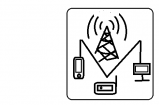Cisco Unified Communications Manager and SIP Trunking
SIP trunking is becoming a very popular way to connect to the Public Switch Telephone Network (PSTN). Session Initiation Protocol (SIP) is a signaling protocol, widely used for setting up and tearing down multimedia communication sessions such as voice and video calls over the Internet. Instead of a line from your local provider (AT&T, Verizon, etc ..) you connect to one of a number of SIP trunk providers, sometimes referred to as Internet Telephony Service Provider (ITSP). They can provide telephone numbers in most of the area codes and provide features like Direct Inward Dial (DID) and Caller-Id over the SIP trunk. Think of Vonage, but on an enterprise scale.
What is confusing to a lot of people is that the SIP Trunk is a logical connection. It is not like POTs, T1 or PRI that are physical connections. The most common ways to connect to the ITSP is over the Internet or a private MPLS circuit. The biggest limitation of using the Internet is the lack of Quality of Service (QOS), but it is surprising how well it works.
SIP Trunks have been supported in Cisco Unified Communications Manager for awhile. Configuring SIP trunks directly into UCM has it limitations. This is why Cisco has recently added expanded SIP trunking support on their routers. Cisco Unified Border Element (CUBE) is a feature set that can be added to the voice gateway. There is an added cost for the software, but when compared with the cost savings of going to SIP it can make a lot of sense.
For more information visit visit my blog at http://www.VoIP-Tutor.com/blog



